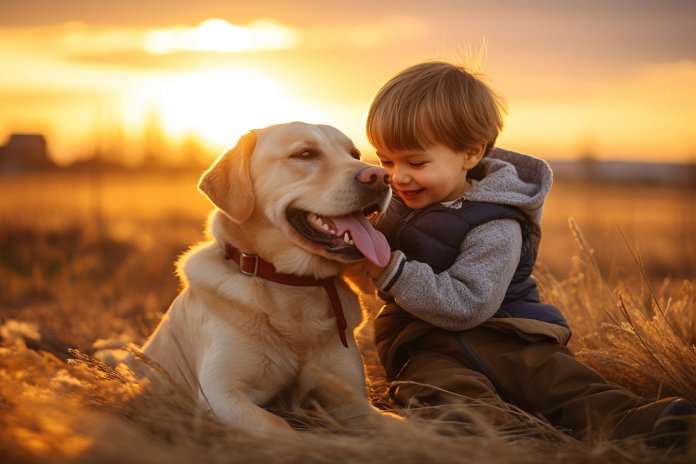
Dogs can help children with autism by providing companionship and love. However, it’s important to remember that every child with autism is different, and having a dog may not be beneficial for everyone. If you and your doctor determine that a dog may help with your child’s autism symptoms, they may form a lifelong bond and gain a loyal friend.
Signs of a Dog Helping with Autism
Instead of discussing signs that a dog is helping a child with autism, let’s look at how you can tell if a child is responding well to a dog. Dogs can help with acceptance and provide companionship to children who often feel alienated. They also aid in social interactions, allowing children to develop confidence and stronger relationships. Additionally, service, therapy, and family dogs can attract people, providing healthy socialization opportunities for the child.
Body Language
Signs that a dog may make a great service dog include being alert, attentive, and having a wagging tail. Other signs of a good service dog include a love for people, ease with interactions, loyalty, and being easy to train.
History of Dogs Helping with Autism
Service and therapy dogs were first introduced in the US in 1929 to assist the blind. In the 1960s, dogs started being used to enhance the lives of people with disabilities, including autism. Recent research has shown that not only specifically trained dogs, but also regular pet dogs can help children with autism. These dogs not only benefit the child with autism but also de-stress the entire family.
Science Behind Dogs Helping with Autism
A study conducted by the Journal of Pediatric Nursing found that children with autism bond strongly with family dogs. Other studies have shown that kids who grow up with dogs have better social skills. Interacting with a dog can temporarily improve social behavior in children with autism because dogs provide unconditional love and companionship.
Training Dogs to Help Children with Autism
When training a service dog for a child with autism, there are generally no special requirements since the dog is primarily a companion. The training process involves the caregiver traveling to Oregon for a 5-day training at the ASDA Headquarters. Afterward, the dog is taken home, and the caregiver continues training for 1-2 weeks. A trainer then visits for one week to address the specific needs of the child and further train the dog in various environments like school and public places.
“Unconditional love and companionship: How dogs can help children with autism”

Tips & Things to Know
1️⃣ Not all children with autism may benefit from having a dog in the house. It is important to consult with a doctor to determine if a dog may provide relief for certain symptoms associated with autism.
2️⃣ Dogs can help children with autism by providing acceptance, companionship, and social interaction. Dogs can help alleviate feelings of alienation and loneliness, and can also help children develop stronger relationships with people.
3️⃣ Research has shown that dogs, both service dogs and pet dogs, can have a positive impact on children with autism. Dogs can help improve social skills, reduce stress for the whole family, and provide unconditional love and companionship.
Frequently Asked Questions, Answered ✅
1. How can dogs help children with autism?
– Dogs can provide companionship and love that children with autism need, helping them feel accepted and less isolated.
– Dogs can help with social interactions and confidence-building, improving the child’s ability to form relationships with people.
– Dogs can assist with socialization by attracting people to interact with the child and providing healthy interaction opportunities.
– Dogs can also help de-stress families living with an autistic child.
2. What are some signs that a dog is helping a child with autism?
– The child shows acceptance and companionship towards the dog.
– The child’s social interactions improve, and they develop a special bond and confidence with the dog.
– People are attracted to the child and dog when they are out, leading to increased socialization for the child.
– The dog displays alertness, listening, and wagging tail, indicating a strong bond and potential as a service dog.
3. What is the history of dogs helping children with autism?
– Service and therapy dogs were first introduced in the United States in 1929, primarily to assist the blind.
– In the 1960s, dogs started being used to enhance the lives of people with disabilities, including those with autism.
– Recent research has shown that not only specifically trained dogs but also regular pet dogs can help children with autism and their families.
4. What does the science say about dogs helping children with autism?
– A study found that 94% of families with an autistic child and a family dog reported a strong bond between the child and the dog.
– Families without dogs also observed positive interactions when their child interacted with other dogs.
– Other studies have shown that having a dog in the house during childhood can improve social skills in autistic children.
– Dogs provide unconditional and non-judgmental love and companionship, which resonates well with children with autism.
5. How are dogs trained to help children with autism?
– For a service dog, the primary caregiver and the dog attend a 5-day training program at the ASDA Headquarters.
– The caregiver gains their ADS certification as a service dog handler during this training.
– The dog is then taken home and given 1-2 weeks to adjust and become comfortable in their new environment.
– A trainer visits for one week to provide personalized training based on the specific needs of the autistic child.
– The dog, child, and family engage in training in various environments, including the child’s school, to ensure the dog is well-equipped to assist.